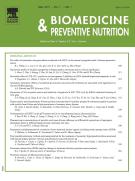Effects of heparinoids from algae on hemostasis and their action on the cycle cell - 12/09/12

Abstract |
Heparin was the first component used as an anticoagulant and antithrombotic agent; therefore, its use presents limitations due to side effects, limited source of material and occurrence of contamination. Marine sulfated polysaccharides provide a low level of contamination by prions and viruses as they are extracted exclusively from a marine source. Heparin-like compounds, sulfated galactans, extracted from red marine algae Hypnea musciformis and fractionated with 1 volume of acetone (F1.0), were evaluated for their anticoagulant activity by activated partial thromboplastin time (aPTT) and prothrombin time (PT) tests by examining their action on enzymatic activity of thrombin and FXa, and their stimulatory action on antithrombotic heparan sulfate synthesis using [35S]-sodium sulfate, and determining how they promote the inhibition of cell proliferation. The aPTT test displayed a low anticoagulant activity at 350μg of F1.0 (![]() 90s) P<0.001. F1.0 caused an inhibition of around 50% on the enzymatic activity of the coagulation factor thrombin. This compound also exhibited a strong stimulatory action on antithrombotic heparan sulfate synthesis (4.6 times) by rabbit aortic endothelial cells (RAEC). The analysis showed that F1.0 causes inhibition of proliferation of RAEC cells due to blocking the cycle cell progression once the cells accumulate at the S phase of the cycle; nevertheless, F1.0 is not cytotoxic for this cell lineage because it does not cause apoptosis or necrosis in RAEC cells. Thus, this polymer has potential against the occurrence of thrombosis once it provides antithrombotic action.
90s) P<0.001. F1.0 caused an inhibition of around 50% on the enzymatic activity of the coagulation factor thrombin. This compound also exhibited a strong stimulatory action on antithrombotic heparan sulfate synthesis (4.6 times) by rabbit aortic endothelial cells (RAEC). The analysis showed that F1.0 causes inhibition of proliferation of RAEC cells due to blocking the cycle cell progression once the cells accumulate at the S phase of the cycle; nevertheless, F1.0 is not cytotoxic for this cell lineage because it does not cause apoptosis or necrosis in RAEC cells. Thus, this polymer has potential against the occurrence of thrombosis once it provides antithrombotic action.
Keywords : Heparin-like compound, Anticoagulant, Antithrombotic, Seaweed, Hypnea musciformis
Abbreviations : aPTT, F1.0, FITC, FX, FXa, H2SO4, HCl, NaCl, PI, PT, RAEC
Plan
Vol 2 - N° 3
P. 163-168 - juillet 2012 Retour au numéroBienvenue sur EM-consulte, la référence des professionnels de santé.
L’accès au texte intégral de cet article nécessite un abonnement.
Déjà abonné à cette revue ?

